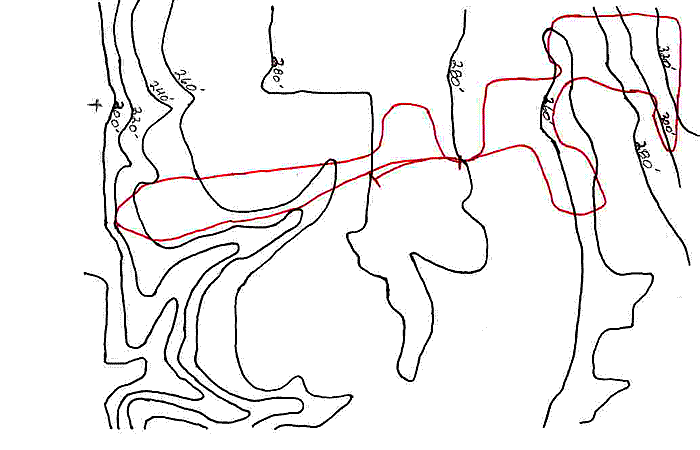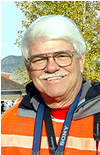the Morley Field course at Balboa Park
by Doug Speck, of DyeStatCal, the Internet home of California track

The Morley Field 5000 meter course, which will be used
for the Foot Locker National Finals for the 17th time this year, is a "fair" cross-country
course which combines flats, gradual ups and downs, and two challenging
hills which must be traversed during the two 1.5 mile loops (which have
the extra distance added to get out to 5000 meters once you cross the
starting line a second time). It is basically a big figure eight loop that
has never presented itself as one where a "definite point to make a move
exists" that has been a deciding factor in a number of the National Finals
events where we observed from 1983 through 1998 as the meet announcer. The
start through the one mile basically has a slight elevation drop during
the run, with the hill coming at the one mile point, with a steep run up
that segment, a tough "across the top" flat area following with the
fatigue of the steep hill, and steep downhill section before a gradual
uphill climb to the start line area to complete the first 1.5 mile loop.
The athletes then repeat the same loop, with that same hill coming up at
2.5 miles, with a downhill, then gradual up to the starting line area (3
mile point), and the 188 yard two inch dash to the finish line after that
point. The course is 95% grass, a little hard-packed dirt, with two road
crossings, which have the athletes crossing cement six total times during
the contest.
Let's take a short jaunt through the course, which the meet contestants
walk through with the help of National meet coordinator Max
Mayo Friday morning. The starting line area actually sends athletes on a
slight downhill through the race's first quarter mile, with athletes
heading west. The first quarter mile, heading west from the
start, is again slightly downhill, with the veteran racers kind of working
out the kinks during this period, with no one ever too crazy in the pacing
department right near the start. The race comes back towards the start to
the 880 point near the tennis courts just before a swimming pool area,
with spectators from the start having the nice luxury of a short walk to
view racers once again here a couple minutes into the event. This second
quarter mile is a very slight uphill, as runners work their way back up
towards the start line area after traversing out to the west end of the
course. After a swing around a swimming pool area, the athletes start a
gradual downhill segment, past the starting line, and down to complete a
loop that consists of a grass area of picnic tables. At around the
Jacaranda Place street crossing is the mile point. The boys one time (Brad
Hudson New Jerseyite who eventually transplanted to Oregon during his prep
career) and the Girls one time (I think Texan Kathy Smith led that year)
were under 4:30 and 5:00 respectively at this one mile point, with
typically mid-high 4:30's-low 4:40's for the boy's and 5:10-5:15 for the
girls there. Someone who is from a portion of the country who has
dominated locally or has gotten away this season without a first mile in
this range may find themselves in a different position early on than they
are used to. With the terrain on the course fairly consistent it seems
some contact near the front pack at this mile point was a factor in most
successful runners through the years, with this not really a "bob and
weave" or type of course that features some segment so tough that it
tremendously slows everyone down and a big move can be made or some other
such race plan.
Right after the mile the runners head up a steep hill that
roughly parallels the Jacaranda Place street that it is next to, with a
flat section across the top that has the runners with pulse rates very,
very high with the excitement of this day and the very steep hill which is
the first time one can really flex their racing muscles after a
geographically uneventful first third of the contest. The downhill that
parallels Upas Drive is very steep, with good downhil runners able to
really let loose here. Again, the course is good for spectators, with
those in starting line area able to take their binoculars and watch the
runners as they go across the mile point, and depending upon the
Eucalyptus tree trimming park plan, watch part of the hill run, see the
crew as they head across part of the the flat segment at the top, and see
them as they come out of the downhill segment that parallels Upas Drive.
If you wonder why the metal baskets are all around the
park here it has to do with frisbee golf, don't ask me to explain, a
popular pastime for those with too much sun and time on their hands.
So, we've gone a bit more than a mile and a quarter as we come off the
hill, with a gradual uphill segment before we cross the starting line
area, where spectators again can add some cheers for favorites at the mile
and a half point. It is always nice to have a San Diegan prep among the
field, which boosts attendance. San
Diegans area very active folks into the running scene, with the event
typically attracting crowds up into the thousands, with the presence of
potential winners Marc Davis, Milena Glusac, or Mebrahtom Keflezighi from
the local prep crowd adding significantly to that number. Interestingly
Davis, who attended San Diego HS, a short ways across the valley from the
course, claimed he could sit in class and look out on the course, dreaming
of championships (that he won in 1986).
After completing the first loop it is not real complicated, as we complete
that same big figure eight configuration a second time. However, now we
have the runners separated by a mile and a half of running. There is a
geographic rivalry to these events, the four regional teams wearing different color running
uniforms, and there is usually a two-team contest that has developed by
this point. Your eventual individual winner does not have to be right on
the lead by the start of this second portion of the course, but they are
usually in the lead pack or close to it. From that one and a
half mile point at the starting line the group is out and back to the
tennis court/pool area for the next half mile point, putting athletes at
two miles when they come past the east end of the tennis court area. The
athletes are spread out a bit, and it is a nice, colorful stream of
runners, certainly appreciating the support of all in their biggest
competition ever!
As the race passes the start line for a third time and
athletes roll down into the picnic loop area, those up front are purring
along, while many, champions most, are wondering how they ever ended up so
far back, impolitely welcomed to a level of competition they had never
before come in contact with. It is not easy! If it is close up front and
places are to be sorted out, the hill section with a bit more than a half
mile to go will make sure that happens. At two and a half miles everyone
is quite fatigued, with a darn tough uphill segment and unforgiving flat
segment on the top that drags on. The thoughts that go through the minds
of champions here is often interesting to hear. Kristen Gordon, 1996
champion, quipped afterwards that the thought that went through her mind
before she swept to victory (we had described her as probably the second
best runner in the U.S. while giving her award two weeks previous at the
California State Meet), was, "that Doug Speck is wrong, I'm not the second
best runner in the United States, I'm the best!" Oh well! Others are more
general, such as "I've done too much work to back down now, etc." Anyway,
there will be at least one good quote from this section of the course from
one of the day's winners. The 2002 girls winner, pint-sized sophomore Zoe Nelson from
Montana, gushed, "I love hills," after taking command on The Hill in the third mile.
After the big final hill there is the downhill
swoop and gradual uphill towards the starting line area (passed a fourth
time during the event here), and nearly 200 meter sprint along a wall of
spectators towards the finish line. The individual and team contests have
unfolded by this time, with all runners 1-32 in each event appreciating
the support of fans along the way.
The weekend is unlike any other, with runners treated royally, and Olympic
level stars around for the fun times! There are 10 minutes or so
of introductions of individual athletes, as
instituted by former Meet Director Dennis McClanahan, followed by some
directions at the starting line that are probably a bit different than the
typical pre-race schedule of individual athletes. The first time through
the entire weekend it takes a relaxed focus that some miss. For many it is
the first introduction to the big-time, with an amazing number of eventual
Olympic level stars indicating that this was their "eye-opener" to what
the world of running could do for them. Bob Kennedy, Sarah Schwald, Suzy
Favor-Hamilton, Adam Goucher, and Deena Drossin are just a few of the
group that went on to "bigger and better" things during their running
careers after a good start here. It is kind of funny years later when
someone like evenutal NCAA Champ and World Championship team member
Schwald says, "When I was a freshman I almost fell over with
nervousness while jogging to the starting line, wondering who these people
were who were telling all this information about my very short running
career during the introductions!"
Elevations of the course

Foot Locker finals
|

